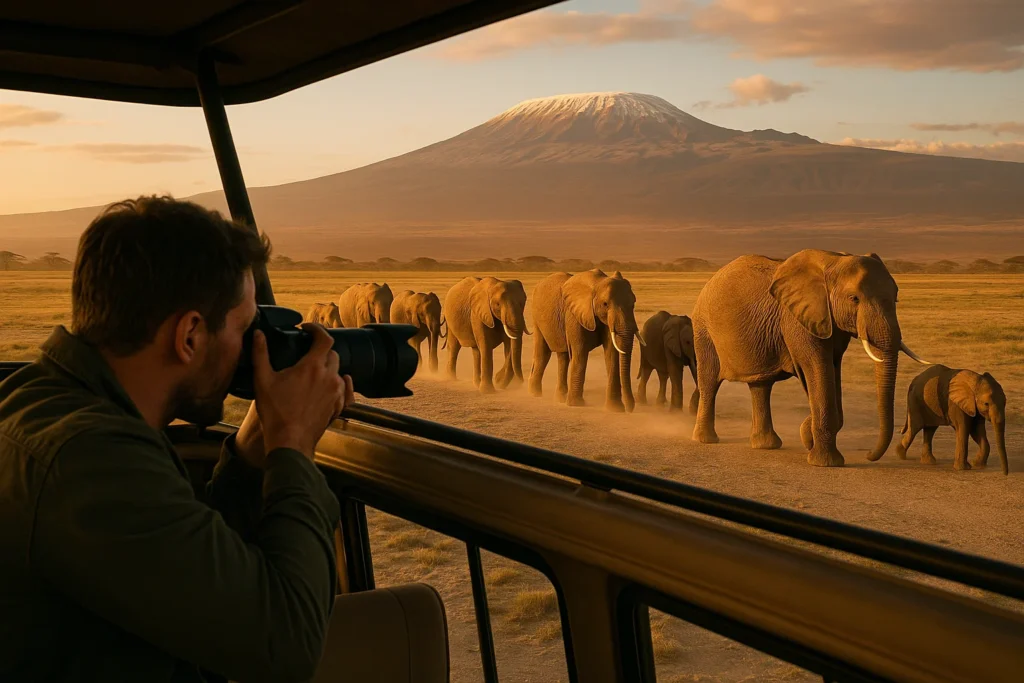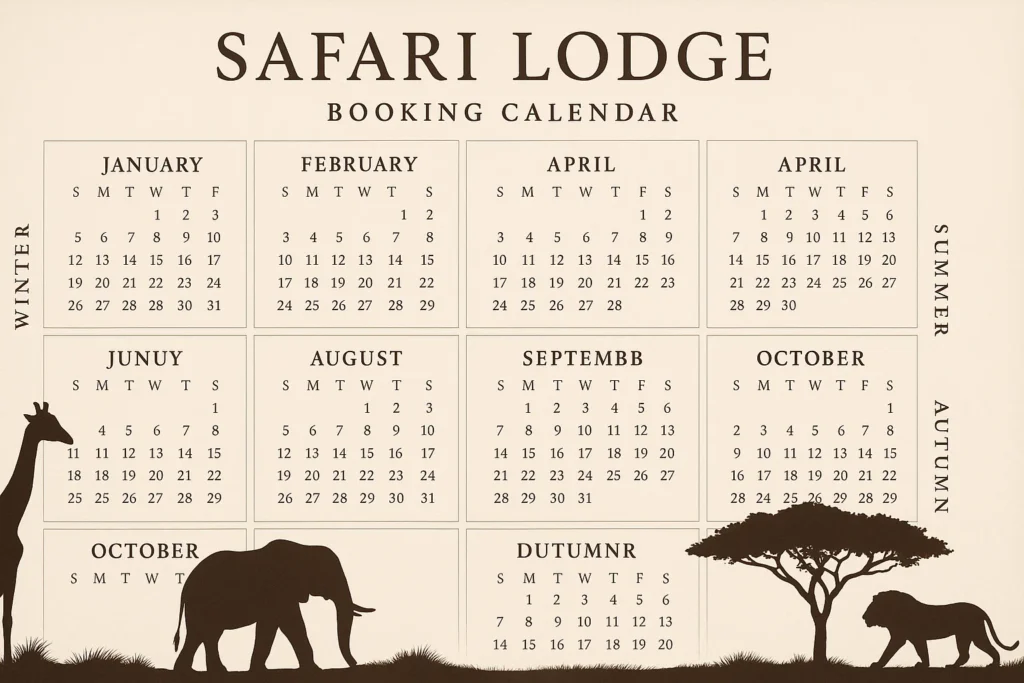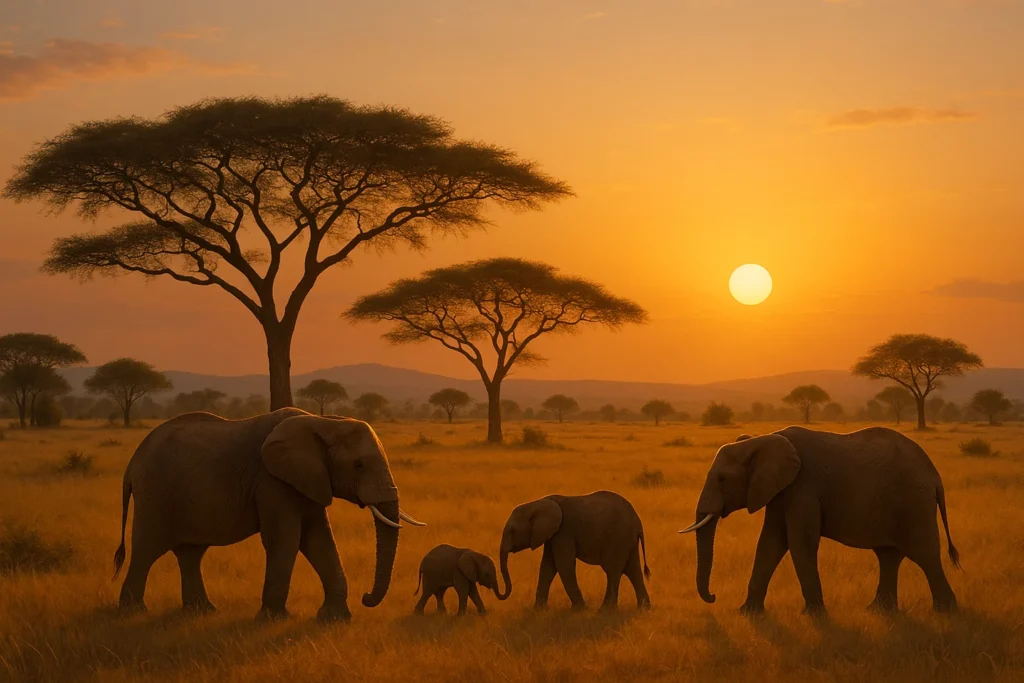Amboseli National Park is every photographer’s dream: vast savannahs, iconic herds of elephants, and Africa’s tallest peak—Mount Kilimanjaro—towering in the background. From dramatic light and dusty plains to intimate wildlife moments, this guide will help you craft unforgettable images in this extraordinary landscape.
Why Amboseli Captivates Photographers
Elephants and Kilimanjaro in perfect tandem
Amboseli’s signature shots often feature elephants walking across dusty plains with Kilimanjaro’s snow-capped summit behind them. This iconic composition is a staple for wildlife photographers and perfectly exemplifies Amboseli’s visual storytelling power.
Rich and varied landscapes
The park boasts a mix of dusty basins, swamps, acacia woodlands, and open grasslands—ideal for crafting diverse visual narratives. These changing ecosystems provide contrasting backdrops and lighting conditions throughout the day.
Timing: Light, Seasons & Behavior
Golden hours are golden for photos
Early mornings and late afternoons offer soft, directional light that enhances textures, shapes, and the glow of dusty air around elephants. Kilimanjaro is also most visible during these hours, especially in the dry season.
Dry season advantage (June–October)
During this time, elephants gather around water sources on the dry lakebed—great for elevated visibility and dynamic compositions. It also features clearer skies and better chances of photographing Kilimanjaro without cloud cover.
Elephant behavior and access
Amboseli’s elephants are habituated to safari vehicles, allowing close yet respectful encounters—perfect for capturing emotional moments like calves playing or matriarchs leading the herd.
Essential Gear and Packing Tips
Lens selection for flexibility
Bring a combination of focal lengths:
- Wide-angle (24–70mm): For sweeping landscapes with Kilimanjaro.
- Telephoto (200–600mm): For detailed wildlife portraits and distant subjects.
Gear protection is non-negotiable
With dusty conditions the norm, pack lens wipes, a blower, microfiber cloth, and even a scarf or kikoy to shield your equipment between shots. A dry bag can help during unexpected showers.
Stabilizing your camera matters
Use a bean bag or window mount to steady your gear during game drives. Tripods are useful for landscape work but often impractical in vehicles.
Insider Techniques for Compelling Shots
Seek unique angles
Don’t just shoot eye-level: kneel, shoot through grass, or explore low vantage points to craft creative perspectives. Look for reflections in swampy areas or shoot against backlight for silhouettes.
Patience and respect equal reward
Wildlife follows their rhythms—wait for the right moment, anticipate interactions, and always observe ethical distances. Let the scene unfold naturally.
Tell stories, not just scenes
Capture more than just the view—focus on instinctive behavior, misty silhouettes, or intimate wildlife interactions that evoke emotion. Think in sequences: wide shot, medium, close-up.
Guided Support & Photography Services
Hire a locally experienced guide
Knowledgeable guides know where light, animals, and landscapes converge—vital for staging memorable images. Many guides also understand photographers’ need for patience and silence.
Photographic studios and tutorials
Lodges like Angama Amboseli offer onsite photo studios with gear rentals and guided lessons. These are ideal for beginners or those wanting to level up their skills in the field.
Tips for Choosing Where to Stay
Prioritize lodges near action
Staying close to central Amboseli, such as Ol Tukai Lodge or Tortilis Camp, means more time shooting during golden hour and offers terrace views of elephants silhouetted under Kilimanjaro. Choose camps with access to key hotspots like Observation Hill and Enkongo Narok swamp.
Final Thoughts
Amboseli National Park is a photographer’s sanctuary—rich in landscapes, wildlife, and storytelling opportunities. With careful timing, the right gear, ethical practices, and keen observation, you’ll return not just with photos, but with visual narratives that capture Amboseli’s soul.
FAQs
Early mornings and late afternoons deliver soft, golden light and dramatic shadows—ideal for capturing landscapes and wildlife.
Yes—wide-angle lenses help include sweeping landscapes and Kilimanjaro, while telephoto lenses let you focus closely on wildlife behavior.
Bring cleaning tools like lens wipes, a blower, and microfiber cloths—and consider protective covers for your camera between shots.
Yes, Angama Amboseli offers guided photographic safaris and in-studio tutorials to refine your skills in the field.
Choose lodges centrally located in Amboseli—ones like Ol Tukai provide early access to game drives and prime views of Kilimanjaro at sunset.
No, drones are prohibited in all Kenyan national parks unless you have a special permit from the Kenya Civil Aviation Authority.
Night drives are not permitted inside the national park boundaries, but some conservancies on the outskirts may allow them.
For personal use, no permits are needed. But for commercial or documentary work, permits must be arranged with Kenya Wildlife Service.






